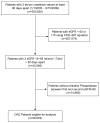Prognostic importance of serum alkaline phosphatase in CKD stages 3-4 in a clinical population
- PMID: 23769134
- PMCID: PMC3783514
- DOI: 10.1053/j.ajkd.2013.04.012
Prognostic importance of serum alkaline phosphatase in CKD stages 3-4 in a clinical population
Abstract
Background: Elevated total serum alkaline phosphatase (ALP) levels have been associated with mortality in the general population and in dialysis patients.
Study design: Retrospective cohort study.
Setting & participants: 28,678 patients with chronic kidney disease (CKD) stages 3 and 4 (estimated glomerular filtration rate, 15-59 mL/min/1.73 m(2)) were identified using the Cleveland Clinic CKD Registry. CKD was defined as 2 estimated glomerular filtration rate values <60 mL/min/1.73 m(2) drawn more than 90 days apart using the CKD-EPI (CKD Epidemiology Collaboration) creatinine equation.
Predictor: ALP levels measured using the calorimetric assay were examined as quartiles (quartile [Q]1, <66 U/L; Q2, 66-81 U/L; Q3, 82-101 U/L; and Q4, ≥102 U/L) and as a continuous measure.
Outcomes & measurements: All-cause mortality and end-stage renal disease (ESRD) were ascertained using the Social Security Death Index and US Renal Data System.
Results: After a median follow-up of 2.2 years, 588 patients progressed to ESRD and 4,755 died. There was a graded increase in risk of mortality with higher ALP quartiles (Q2, Q3, and Q4) compared to the reference quartile (Q1) after adjusting for demographics, comorbid conditions, use of relevant medications, and liver function test results. The highest ALP quartile was associated with an HR for ESRD of 1.38 (95% CI, 1.09-1.76). Each 1-SD (42.7 U/L) higher ALP level was associated with 15% (95% CI, 1.09-1.22) and 16% (95% CI, 1.14-1.18) increased risk of ESRD and mortality, respectively.
Limitations: Single-center observational study; lack of complete data, including parathyroid hormone level, for all study participants, and attrition bias.
Conclusions: Higher serum ALP levels in patients with CKD stages 3-4 were associated independently with all-cause mortality and ESRD.
Keywords: Alkaline phosphatase; chronic kidney disease; end-stage renal disease; mortality.
Copyright © 2013 National Kidney Foundation, Inc. Published by Elsevier Inc. All rights reserved.
Figures
References
-
- Jono S, Shioi A, Ikari Y, Nishizawa Y. Vascular calcification in chronic kidney disease. J Bone Miner Metab. 2006;24(2):176–181. - PubMed
-
- Tonelli M, Curhan G, Pfeffer M, et al. Relation between alkaline phosphatase, serum phosphate, and all-cause or cardiovascular mortality. Circulation. 2009;120(18):1784–1792. - PubMed
Publication types
MeSH terms
Substances
Grants and funding
LinkOut - more resources
Full Text Sources
Other Literature Sources
Medical




